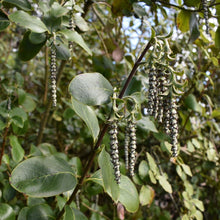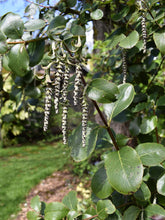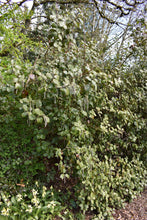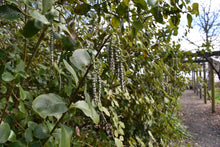
Garrya elliptica
Silk tassel is a captivating evergreen “arborescent shrub”, which means it can get so large it may as well be a small tree! Its leathery leaves are dark green on top and pale and wooly on the bottom, bringing an attractive texture to your habitat garden. But it’s the unique blooms that gardeners covet. Starting as early as December, long silvery catkins spill plentifully from its branches and persist until spring. This species is diecious, meaning each plant will have either male or female reproductive organs, rather than both on the same plant; with males having slightly longer and more spectacular tassels, while female catkins mature into grape-like clusters of fruits that attract and support backyard birds.
- Plant type/canopy layer: evergreen, perennial, large shrub or small tree
- Size at maturity: 5-20' tall, 8-16' wide
- Light requirements: full sun to part shade
- Moisture requirements: moist to dry soil, may require infrequent summer water
- Bloom time: Jan - April
- Growth rate/ease: medium growth rate, easy to grow
- Wildlife support: female fruits attract and feed birds; overall plant provides refuge to birds
- Native habitat/range: typically found within specific habitats such a sea cliffs, dunes and foothills, hidden among the chaparral, scrub and oak woodlands in the Coast Range and near the Pacific Ocean from southwest Oregon to southern California. Portland Plant List - no.
- Special features & uses: deer resistant; landscape uses include woodland garden, erosion control, habitat hedgerow and visibility screen or windbreak
Gardening with Coast Silk Tassel: Try silk tassel as part of a screen, habitat hedgerow or simply to add some winter enchantment to your garden. Evergreen shrubs can be tough to come by in the native plant pallet - so it’s relatively effortless to find a great place for one as versatile as silk tassel. It will be the happiest in full sun, but can be planted in partial to mostly shady areas as well, and it's not fussy about soil type, as long as it's well-drained. In shadier spots, it can be moderately drought tolerant, but will thrive if watered infrequently but deeply during the summer drought (i.e. every couple of weeks). Its tough leaves tolerate salt spray and are deer resistant. Avoid planting in frost-prone or very cold sites. If you need to prune it, do so immediately after it finishes flowering.
Photo Credits: Nikkie West, Sparrowhawk Native Plants







